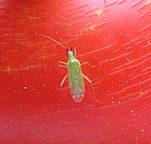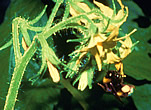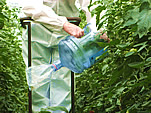
What is IPM?
IPM programmes are knowledge-based and depend on a thorough understanding of the four -way interactions between plants, herbivores, natural enemies and environmental conditions. Day to day decisions are based on regular crop monitoring which provides topical information about the size of populations of pests and beneficial species. Every action that is taken can effect some other aspect of the IPM programme and so it is vitally important that practitioners fully understand the broader implications of their decisions.
IPM programmes are usually based on biological techniques but also draw on physical and cultural control measures integrated with strategic applications of target specific and short persistence pesticides. There are now many biological products available to growers including parasitoids and predators, as well as entomopathogenic fungi, nematodes and bacteria. Physical controls include the use of screens, traps and barriers, while cultural controls make use of tolerant cultivars, good hygiene practices and manipulation of the growing environment. The key to success is to understand how to use these products singly or in combination to maintain the pest populations below economic damage thresholds.

Whole crop IPM programmes may be based on numerous individual components. Each pest is commonly controlled with a combination of primary and secondary control measures. The primary systems are usually based on biological agents and their use has traditionally been reactive; i.e. the pests are detected by crop monitoring at an early stage of establishment and the appropriate biological control agents are then ordered and released in the crop. This inevitably allows the pest to gain a head start and the most common reason for failure is that the pest population crosses the economic damage threshold before control is achieved.
The secondary control measures have historically been target specific chemicals that can be used to redress the balance between the pest and beneficial populations when the pest damage approaches the economic damage threshold. Minimal use of IPM compatible chemicals in this way has been a major factor in the success of the overall programmes in salad crop production. However, practitioners are now seeking more sustainable second lines of defence and alternative strategies based on entomopathogenic nematodes and fungi have been developed.

Another means of preventing pest populations crossing economic damage thresholds is to release them prophylactically so that they are already present in the crop when the pest arrives. In this case, there is no delay before the natural enemies are released and they begin to have an impact at a much earlier stage of the pests’ population growth. Some methods have been developed of maintaining sufficient numbers of healthy natural enemies in the crop before the arrival of their natural food source by:
i) frequent inundative releases of natural enemies,
ii) using predators which can gain nutrition from the plants,
iii) predators which survive by scavenging on other prey, or
iv) providing predators with alternative source of food.


